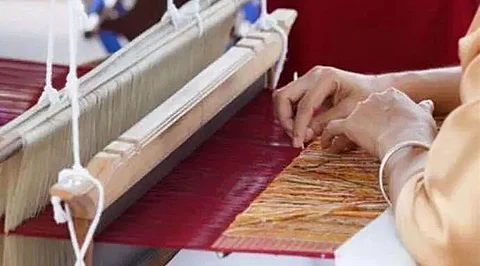
- Home
- Live Blog
- Breaking News
- Top Headlines
- Cities
- NE News
- Sentinel Media
- Sports
- Education
- Jobs

Handloom practice in India has been keeping alive centuries-old vibrant weaving crafts of different communities and generates huge livelihood opportunities for rural artisans. Data-driven decisions relating to handloom practices can be game-changers in tapping huge potential to turn these livelihood opportunities into gainful employment. The latest available data provide a deep insight into some of the key challenges that the handloom sector is grappling with. The 4th All India Handloom Census 2019-20 data reveal that four states- Assam, West Bengal, Manipur and Tamil Nadu – account for 18 lakh of the total 26.73 lakh weavers' households in the country. Assam leads these four states with 10.9 lakh weavers' households. The survey reveals a gloomy picture of over 67 per cent of weavers earns less than Rs 5,000 a month. Only 26.2 % of handloom workers (24.9 % in rural and 34.9 in urban) earn between Rs. 5,001 and Rs 10,000 while only 4.5 % of them earn between Rs 10,001 and Rs 15,000 a month. Households earning of Rs 15,001-20,000 a month is a meagre one per cent. Low income of households can be attributed to weaving practice being non-remunerative and a part-time activity for 49.2 %. Almost one-third of weavers' households do not possess a loom and that limits their earnings only as workers on looms owned by other households. The majority of weavers (73.2%) are independent and only 0.4% are under Khadi and Village Industries Commission and 6.3% are under cooperative societies. This speaks volumes of the failure of the KVIC and the cooperative movement in handloom sectors. The presence of a large number of independent weavers can also be seen as an opportunity to tap their talent and skills in increasing their earnings through new and innovative intervention. The survey data further show that the average number of person-days increased to 208 from 183 days during the third round of census conducted in 2009-10. It is a paradox that despite having 40.77% of the country's weavers' households, Assam does not figure among the top five states having the highest average number of person-days. The financial inclusion of the vast majority of weavers in Assam is another issue that calls for urgent attention of bank and handloom authorities. The data reveal that only 88,357 handloom workers in the state have bank accounts and the majority of the workers remain excluded from credit linage and financial services which play a crucial role in augmenting the income of lakhs of weavers' households. Insurance coverage of weavers' households in the country is very low as 3.3% in rural areas and 7% in urban areas and only 2.6% are aware of the Weavers' Health Insurance Scheme. Women account for 72.3% of the handloom workers, the convergence of welfare measures for women with schemes and programmes for handloom sectors can benefit a large number of households. Augmenting the income of weavers' households, therefore, also plays an important role in their economic empowerment and social uplift. While a large part of the handloom products is consumed in the domestic market, the country also has a huge export market. According to statistics of the India Brand Equity Foundation (IBEF), the export of handloom products from India was valued at 319.02 million US Dollars during the last financial year against 343.69 million US dollars in 2019. Diversifying the country's handloom export basket with more innovative designs and exclusive traditional products from the northeast region can boost exports. Meticulous planning at the macro and micro levels is needed to avoid overlapping similar designs and oversupply of the same products in the market. Grooming exporters from among weavers' households can establish productive linkage of the traditional weavers from the region with the vibrant export market. Some of the handloom products from the region attracting buyers overseas are pointers of the untapped potential in the region. Replicating these success stories requires handholding support to the weavers' households which is yet to be seen. Assam government, KVIC, entrepreneurs and other stakeholders analysing the big data of the handloom sector presented in the Handloom Census and reviewing why the sector has remained non-remunerative for the majority of weavers' households in the state can lead to answers to the question. Attracting educated unemployed youth into the sector both as weavers as well as traders and entrepreneurs can be a pragmatic solution to ignite dreams of tapping the export market but will require an innovative approach. Data show that only 3.6% of handloom and allied workers are graduates. An improvement in earnings in the sector will attract more educated youth to look for employment and income-generating activities instead of looking for jobs only in government or private sectors. It is also crucial to keep alive the rich heritage and tradition. It is time the state focused its attention on its handloom sector to rescue it from decades of sluggishness and lack of imagination. Out-of-the-box solutions are needed to address the problems that Assam's handloom households are grappling with.